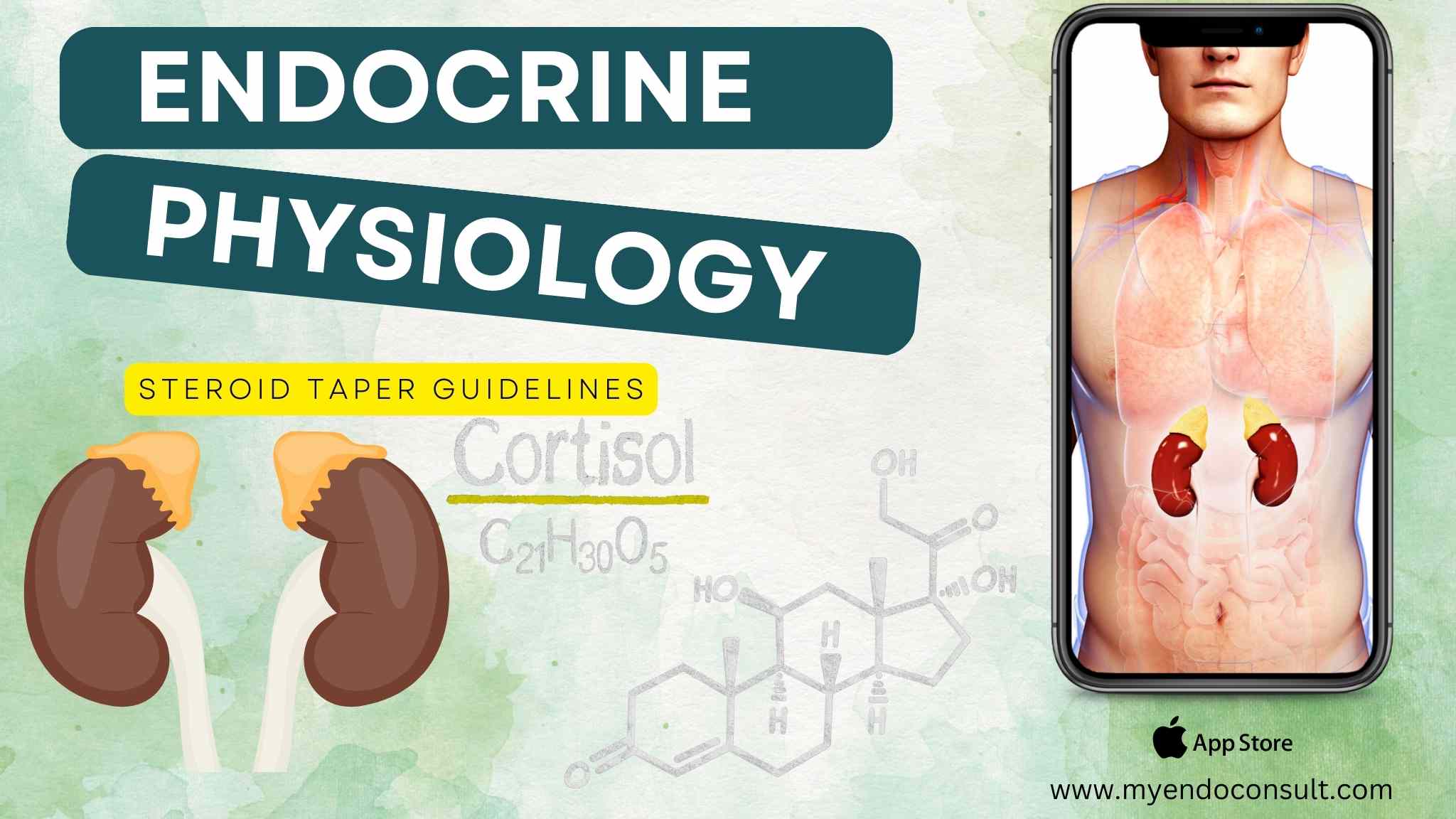
Prolonged exposure to supra-physiologic doses of glucocorticoids (GCs) can suppresses the hypothalamic-pituitary-adrenal axis, requiring steroid weaning to prevent signs/symptoms of cortisol deficiency.
Limited evidence exists to guide wean speed and duration. Acute signs/symptoms of adrenal insufficiency: lethargy, anorexia, abdominal pain, vomiting, dehydration, tachycardia, hypotension, cyanosis, cold skin, hyponatremia with or without hypokalemia, metabolic acidosis, hypoglycemia. A simplified approach to tapering steroids after either short-term or long term steroid exposure.
Tapering Protocol for Glucocorticoids
Duration of Steroid Therapy | Initial Steroid Dose | Tapering Strategy | Considerations |
Short-term (less than 3 weeks) | Any dose | – Rapid taper or immediate cessation. – May not require tapering for less than 1 week of use. | – Lower risk of HPA axis suppression. – Monitor for acute withdrawal symptoms. |
Intermediate-term (3-8 weeks) | High dose (>20 mg prednisone or equivalent) | – Reduce dose by 10-20% every 1-2 weeks. – Adjust based on clinical response and withdrawal symptoms. | – Moderate risk of HPA axis suppression. – Close monitoring for signs of adrenal insufficiency. |
Long-term (more than 8 weeks) | High dose (>20 mg prednisone or equivalent) | – Reduce dose to 20 mg/day over several weeks. – Further taper by 2.5-5 mg every 2-4 weeks until reaching 5-10 mg/day.- Then, decrease by 1 mg every 2-4 weeks. | – High risk of HPA axis suppression.- May require several months for complete taper. – Consider additional testing for adrenal function. |
Long-term (more than 8 weeks) | Moderate dose (5-20 mg prednisone or equivalent) | – Decrease by 2.5-5 mg every 2-4 weeks. – Once at 5 mg/day, taper by 1 mg every 2-4 weeks. | – Gradual reduction to prevent adrenal crisis. – Symptoms of steroid withdrawal should be monitored. |
Long-term (more than 8 weeks) | Low dose (≤5 mg prednisone or equivalent) | – May taper more rapidly.- Decrease by 1 mg every 1-2 weeks. | – Lower risk of withdrawal symptoms.- Monitor for signs of adrenal insufficiency. |
During Stressful Periods (e.g., illness, surgery) | Any dose | – Temporary increase in steroid dose may be needed.- Return to tapering regimen post-stressful event. | – Important to prevent adrenal crisis during stress.- Communicate with healthcare provider regarding adjustment. |
Copyright. The MyEndoConsult.com Team
Perioperative Glucocorticoid Therapy Recommendations
HPA Axis Status | Patient Criteria | Recommendations |
Nonsuppressed HPA Axis | – Patients on any dose of glucocorticoids for less than 3 weeks. – Morning prednisone <5 mg daily (or equivalent) for any duration. – Less than 10 mg of prednisone (or equivalent) every other day. | – Continue same glucocorticoid regimen perioperatively. – No need for preoperative HPA axis evaluation or supraphysiologic glucocorticoid doses. |
Suppressed HPA Axis | – Current intake of >20 mg/day of prednisone (or equivalent) for more than 3 weeks. – Patients with clinical Cushing’s syndrome. | – Additional perioperative glucocorticoid coverage recommended. – Specific regimen based on type and duration of surgery. |
Intermediate HPA Suppression | – Patients taking 5-20 mg of prednisone (or equivalent) for more than 3 weeks. – Patients with a history of glucocorticoid injections (3 or more within 3 months prior to surgery). – Patients on chronic inhaled or high-potency topical glucocorticoids. | – Undergo preoperative HPA axis evaluation. – Empiric glucocorticoid coverage for urgent/emergency surgeries. – Additional glucocorticoid therapy based on morning serum cortisol levels and ACTH stimulation test results. |
Predicting Adrenal Insufficiency Risk
| AI Risk | Risk factors | Tapering Guidelines |
| Low Risk | LESS THAN 2 weeks (14 days) of GC exposure. NOT critically ill (vasopressors and/or mechanically ventilated) | Stop GCs (or return to home physiologic replacement dose) with NO taper. If taper requested, taper by 25% of reference dose every 2-3 days |
| Possible Risk | 2 – 3 weeks (14-21 days) of GC exposure. LESS THAN 2 weeks (14 days) of GC exposure AND critically ill (vasopressors and/or mechanically ventilated) | Taper by 25% of reference dose every 4-7 days. Slow the speed of glucocorticoid taper if signs/symptoms of adrenal insufficiency occur |
| High Risk | GREATER THAN 3 weeks (21 days) of GC exposure | Strongly consider ACTH stim test. GREATER THAN 18 = normal (should not require steroid wean) 15 – 18 = call endocrinology LESS THAN 15 = suppressed (will require steroid wean) |
Tests for Evaluating Adrenal Insufficiency
Test Name | Description | Procedure | Interpretation |
ACTH Stimulation Test | Measures adrenal response to ACTH (adrenocorticotropic hormone). | – Injection of synthetic ACTH (cosyntropin).- Measure cortisol levels at 0, 30, and 60 minutes. | – Normal response: Cortisol level increases to a certain threshold (often >18 mcg/dL or 500 nmol/L).- Abnormal response: Blunted or no increase in cortisol indicates adrenal insufficiency. |
Insulin Tolerance Test (ITT) | Evaluates integrity of the entire HPA (hypothalamic-pituitary-adrenal) axis. | – Induce hypoglycemia with intravenous insulin.- Monitor glucose and cortisol levels. | – Normal: Significant increase in cortisol and growth hormone.- Abnormal: Inadequate cortisol response indicates HPA axis dysfunction. |
Metyrapone Test | Assesses the pituitary’s ability to secrete ACTH. | – Metyrapone blocks cortisol synthesis. – Measure 11-deoxycortisol and ACTH levels. | – Normal: Elevated 11-deoxycortisol and ACTH. – Abnormal: Failure to elevate indicates impaired pituitary ACTH secretion. |
CRH Stimulation Test | Measures pituitary ACTH and adrenal cortisol response to CRH (corticotropin-releasing hormone). | – Inject CRH and measure ACTH and cortisol at various intervals. | – Normal: Increased ACTH and cortisol. Trending – Abnormal: Lack of response indicates pituitary or adrenal dysfunction. |
Baseline Serum Cortisol | Determines cortisol level without stimulation. | – Blood sample typically collected in the morning when cortisol levels are highest. | – Low levels suggest adrenal insufficiency. – Interpretation depends on local laboratory reference ranges. |
Salivary Cortisol Test | Assesses free cortisol levels in saliva, reflecting unbound cortisol in blood. | – Saliva samples collected at specific times, often late at night. | – Elevated levels may indicate Cushing’s syndrome; low levels can suggest adrenal insufficiency. |
24-Hour Urinary Free Cortisol | Measures cortisol excretion over 24 hours. | – Collect all urine over a 24-hour period. | – High levels can indicate Cushing’s syndrome; low levels may suggest adrenal insufficiency. |
Tapering schedules after short-term steroid exposure
Any patient with <3 weeks of glucocorticoid treatment is unlikely to have clinically significant adrenal suppression. If the medical condition allows it, glucocorticoid treatment can be stopped acutely. It should be noted that significant stress within one week of stopping steroids should, however, be covered with glucocorticoids.
Exceptions to the above general rule….
- Patients with other possible reasons for adrenal insufficiency
- Received >40mg prednisolone (or equivalent)
- Evening doses of hydrocortisone (Due to greater Hypothalamic-Pituitary-Adrenal axis suppression)
- Short courses prescribed within 1 year of cessation of long-term steroid therapy
Tapering schedules after long-term steroid exposure
Supraphysiological doses of steroids refer to >5mg of prednisone or the equivalent of glucocorticoid (see the steroid conversion table). Patients exposed to a cumulatively high dose of steroids or a longer duration of exposure require a slower taper of steroids.
Dose reduction depends on disease activity. (If the underlying disease has resolved, reduce prednisone by 2.5mg every 3-5 days till a dose of 5mg prednisone steroid equivalent is reached. Next...
Once a daily equivalent dose of 5mg is reached (rate of reduction should be slower to allow recovery of HPA axis). Next...
Consider switching to PO hydrocortisone (average BSA estimate of 20mg daily in the morning only). This has a shorter half-life and allows recovery of the axis. (less prolonged suppression of ACTH). Next...
- Daily hydrocortisone dose should be reduced by 2.5mg every 1-2 weeks or as tolerated until a dose of 10mg is reached. Next...
- After this 2-3 month taper period, a 9 AM cortisol is checked 24 hours after the last dose of hydrocortisone. Then interpret cortisol levels...
- If cortisol is >10mcg/dl, then hydrocortisone can be stopped and a cortrosyn test performed.
- If cortisol is <10mcg/dl, then continue hydrocortisone 10mg for another 2-3 months and repeat 9 AM cortisol.
If basal cortisol is >14mcg/dl, stop regular hydrocortisone and administer in emergency only. Supplemental stress dose steroids during intercurrent illness are not required.
Steroid Conversion Table
| Type of Steroid | Equivalent Total Daily Dose (mg) | Doses per day |
| Hydrocortisone | 15-25 | 2-3 |
| Prednisone | 5-7.5 | 2 |
| Prednisolone | 4-6 | 2 |
| Dexamethasone | 0.25-0.5 | 1 |
| Fludrocortisone | 0.05-0.2 | 1 |
Comparison of Mineralocorticoid and Glucocorticoid Potency of Steroids
| Glucocorticoids | Equivalent Dose (mg) | Glucocorticoid Potency | Mineralocorticoid Potency | Half-life (hrs) | Physiologic Dose |
| Short-Acting | |||||
| Hydrocortisone | 20 | 1 | 1 | 2 | 6 - 12 mg/m2/day |
| Cortisone | 25 | 0.8 | 0.8 | 0.5 | |
| Intermediate-Acting | |||||
| Prednisone | 5 | 4 | 0.3 | 2.5 | 1.5 - 3 mg/m2/day |
| Prednisolone | 5 | 5 | 0.3 | 2 | 1.5 - 3 mg/m2/day |
| Methylprednisolone | 4 | 5 | 0 | 2 | 1.2-2.4 mg/m2/day |
| Long-Acting | |||||
| Dexamethasone | 0.75 | 30 | 0 | 4.5 | 0.2-0.4 mg/m2/day |
| Betamethasone | 0.6 | 25-40 | 0 | 6.5 | |
Try our Steroid Conversion Calculator. An easy way to convert between various glucocorticoid formulations
Performing the Cortrosyn stimulation Test after a steroid taper
A dynamic test for the evaluation of suspected adrenal insufficiency.
The test cannot distinguish between primary and secondary AI
Limitations of this test
• Estrogen in OCPs may increase corticosteroid-binding globulin and thus increase total serum cortisol.
• Low albumin can lead to a spuriously low serum cortisol
• It does not distinguish between primary and secondary AI (normal stimulation test if adrenocortical atrophy has not set in yet)
How to Perform the Test
Draw a baseline serum cortisol (at any time, need not be in the early morning), then inject 250mcg of Cosyntropin(Cortrosyn), IM or IV. Draw serum cortisol (total) at 30 and 60 minutes.
Interpretation of test results
Peak serum cortisol >18mcg/dL or an increment of >7mcg/dL over the baseline cortisol level rules out adrenal insufficiency. For newer cortisol assays, a level of >14mcg/dl, effectively rules out AI.
References
- Campbell AM, Martin JR, Erstad BL. Corticosteroid Tapering Regimens in Rheumatic Disease: A Systematic Review. J Clin Rheumatol. 2020 Mar;26(2):41-47.
- Liu D, Ahmet A, Ward L, Krishnamoorthy P, Mandelcorn ED, Leigh R, Brown JP, Cohen A, Kim H. A practical guide to the monitoring and management of the complications of systemic corticosteroid therapy. Allergy Asthma Clin Immunol. 2013 Aug 15;9(1):30.
- Richter B, Neises G, Clar C. Glucocorticoid withdrawal schemes in chronic medical disorders. A systematic review. Endocrinol Metab Clin North Am. 2002;31(3):751-778. doi:10.1016/s0889-8529(02)00008-7
- Becker DE. Basic and clinical pharmacology of glucocorticosteroids. Anesth Prog. 2013;60(1):25-31; quiz 32. doi:10.2344/0003-3006-60.1.25
Kindly Let Us Know If This Was helpful? Thank You!


